The September 2010 issue of the magazine “Petroleum in Western Australia” has a graph on WA’s domestic natural gas demand and supplies up to 2030 (“The Outlook for Domestic Gas in Western Australia”, page 20) which shows basically flat supplies in the low case scenario, well below any of the 3 demand scenarios.
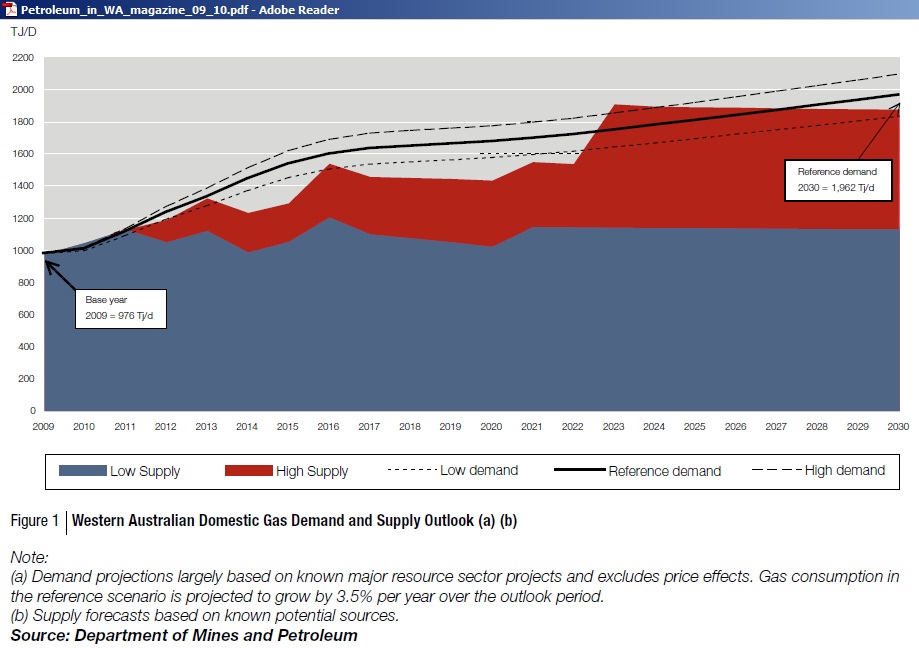

Most of this gas is used in the mining, manufacturing and electricity generation industries.
http://www.dmp.wa.gov.au/Petroleum/Publications-1601.aspx
Petroleum In Western Australia Sep 2010
http://www.dmp.wa.gov.au/Documents/Petroleum/PD-RES-PUB-119D.pdf
The Australian Financial Review had this article on 17/9/2010:

The Dom Gas Alliance wrote in April 2009
Does WA have abundant reserves of gas?
“Claims that WA has over 100 years of gas are incorrect. WA only has around 130 Tcf of natural gas reserves – based on a 50% probability of recovery.
Only 17% of WA’s reserves relates to developed fields. The bulk of reserves are located offshore and in deep water. Many of the fields have gas quality issues which impact on development economics. There is no certainty that it will be economic to develop all of these gas reserves.
Despite holding just over 2% of world natural gas reserves, Australia aspires to be an “LNG superpower” and the world’s second largest gas exporter. The bulk of these resources are located in Western Australia.
When are resources likely to be exhausted?
Western Australia’s natural gas resources could be fully depleted within 30 years. In addition, if government and producer export targets of 50-60 million tonnes per annum of LNG are reached, the total existing resources of the Carnarvon Basin will be fully committed by 2015-2020.
When gas resources are committed as long term LNG export contracts, they are unable to meet current and emerging needs of the local economy.”
http://www.domgas.com.au/documents/WAgassupply-QAs-12-3-09.pdf
A recent report for the Domgas Alliance explaining more details on the above graph can be found here:
http://www.latentpet.com/_content/documents/575.pdf
DomGas Security Reports 2009 and 2010:
https://www.domgas.com.au/reports
This raises the question: where will the natural gas come from which will be needed to convert our buses and trucks to CNG or LNG? Can the Australian crude oil decline be offset with increasing quantities of gas? Let’s do a simplified energy balance calculation by adding the shortfall from the Geoscience Australia decline graph to the above (domestic) gas demand curve.
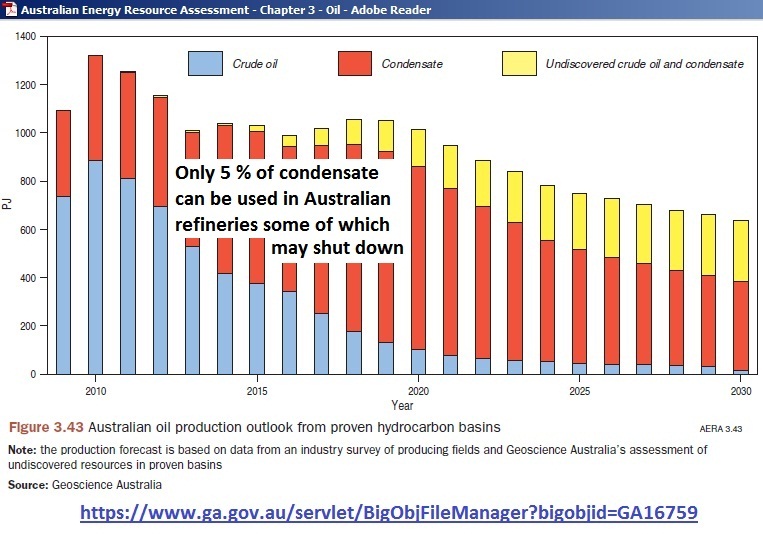
The 2 graphs have different scales (1,000 TJ/d equals 365 PJ pa), so we add to the PWA graph a PJ scale on the right hand side.
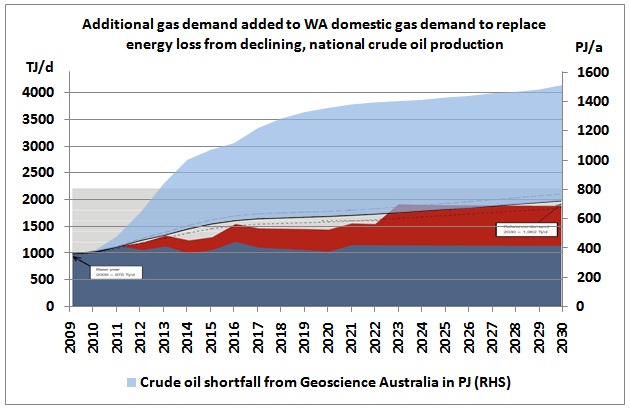
Gas demand would practically double! There is no provision whatsoever in the existing gas demand forecast to use gas as a transport fuel in sufficient quantities to ensure a timely transition.
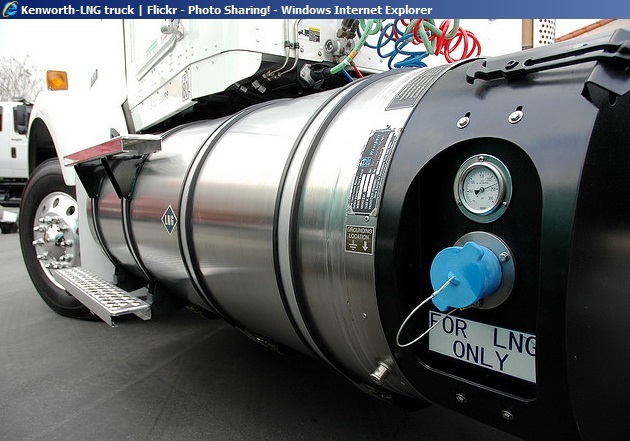
http://www.flickr.com/photos/truckpr/3460173138/in/photostream/
Why are we exporting so much of our offshore gas? We are now digging more dirty fossil fuel holes right in Sydney’s neighbourhood (coal seam gas)
Cover-up: secret plans to mine gas
“Billions of dollars worth of coal seam gas will be mined around Sydney and the profits split among giant coal companies, including Peabody Energy and Rio Tinto, leaked confidential company document reveals.
Coal seam gas generates lower greenhouse gas emissions than coal but some of the extraction methods, which involve using highly toxic chemicals to break up rocks, can contaminate water.
”What does Peabody have to hide?” said Jeff Angel, the executive director of the Total Environment Centre, which has been scrutinising the impact of mining on drinking water catchments.”
http://www.smh.com.au/environment/coverup-secret-plans-to-mine-gas-20100922-15n0p.html
”If you could imagine drill holes 600 metres apart, each with an all-weather access road over vast farming areas – that would be the end of farming as we know it,” said Robert Barry, a former Sydney merchant banker who has land holdings on the Liverpool Plains.
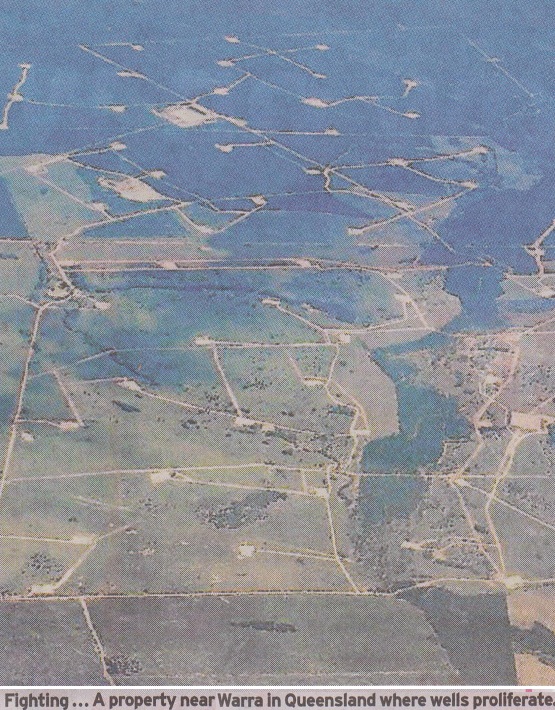
Debate about gas drilling turns toxic
http://www.smh.com.au/environment/debate-about-gas-drilling-turns-toxic-20100924-15ql3.html
And even most of that coal seam gas is planned for LNG exports. Examples from Queensland are here:
http://www.arrowenergy.com.au/icms_docs/70762_Cera_week.pdf
Conclusion: If government policy on our gas supplies is not immediately changed to include gas as transport fuel there will be a big surprise when in the next phase of peak oil the oil supply problem becomes physical and the transport industry cries out for gas supplies including the appropriate gas distribution infrastructure.